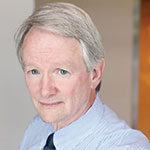Jeffrey A. Whitsett, MD, recipient of this year’s Edward Livingston Trudeau Medal, spoke with the ATS Daily Bulletin about his research on surfactant production and function in preterm infants, the work he’s doing now, his clinical contributions, and more.
Q: Tell us about your research involving surfactant production and preterm infants.
A: Neonatal Intensive Care Units (NICUs) were established in the 1960s as advances in clinical care and fundamental insights into biochemistry and physiology began to enable better survival of newborn infants. My career path as a pediatrician became clear to me while training at Columbia University College of Physicians and Surgeons, as we began to care for smaller preterm infants and other critically ill children. It was clear that respiration—both the physiology and biochemistry—remained a formidable hurdle limiting their survival.
Fundamental insights regarding the surfactant system from Mary Ellen Avery, Jeremiah Mead, John Clements (all previous Trudeau awardees), and Goran Enhorning, to name a few, provided the insights supporting the development of surfactant replacement therapy.
Starting my research laboratory during my neonatology fellowship at Cincinnati Children’s Hospital Medical Center—circa 1976—it seemed that we did not understand why surfactant lipids spread rapidly and tolerated “dynamic” compression and “de-compression” (churning) during the breathing cycle. Although biochemical studies of surfactant extracts that were surface “active” concluded that there were no proteins in the lipids—circa 1980—we nevertheless searched for proteins that might confer the remarkable functions of pulmonary surfactant.
Q: What kind of impact has that research had for premature infants?
A: Now, nearly 40 years later, the field has a much clearer understanding of the structure, function, and regulation of surfactant lipids and proteins. Identifying SP-B and SP-C in the surfactant extracts, we worked closely with Abbott Laboratories to optimize the manufacturing and testing of surfactant replacements and were involved in the FDA approval process of surfactant for the treatment of infants with RDS. We now have an in-depth understanding of SP-A, B, C, and D, the complexity of alveolar surfactant homeostasis, the functions of alveolar type 2 cells, and alveolar macrophages.
We worked at an early time in the “molecular biology” revolution: cloning, deleting, and mutating genes in vivo, discovering gene and protein structures, and uncovering the gene networks that mediate lung structure and function. Children with mutations in genes critical for surfactant homeostasis and lung formation were identified. Advances in applying continuous positive airway pressure and mechanical modes of ventilation, antenatal steroids, infant nutrition, and surfactant replacement transformed the care of preterm infants worldwide. Progress was made possible by fundamental scientific and clinical advances contributed by so many.
Q: What are you working on now?
A: I continue to be enthralled by the exponential pace of technology and discovery in science. Scientific advances were fueled by the human genome, cell-molecular biology, and now the application of bioinformatics and computer science to the world of “Omics.”
My laboratory continues to be intrigued by the surfactant system, by the role of respiratory epithelium in health and disease, the molecular circuitry forming and repairing the lung, and the interrelationships among epithelial biology, inflammation, innate host defense, and the pathogenesis of chronic lung disease.
What are the molecular and cellular processes underlying chronic lung disorders in children and adults for which we lack understanding and therefore lack effective treatments? What are the cells that form the lung? How do they find themselves in correct numbers and in appropriate places to maintain lung structure and function? Will understanding the molecular circuitry that creates lung architecture and its responses to environmental challenges provide the insights needed to prevent and treat pulmonary disease? There are many roads to travel and more questions to answer.
Q: What clinical contributions have you made in your region?
A: I have been privileged to care for newborn infants and, throughout my career, perhaps there has been no greater joy than to see critically ill children recover, head for home, and start their lives. As clinical expertise in the care of newborns grew in the late 20th century, it was increasingly clear that all newborn infants would benefit from the expert care that advances in neonatology and pediatrics had made possible. While neonatal intensive care was then primarily a practice in universities and tertiary centers, we thought that collaborating with all delivery hospitals in our region might improve clinical outcomes.
We established a clinical network with all local hospitals in our region, now consisting of five tertiary-quaternary care hospitals and an additional nine delivery centers, covering nearly 30,000 infant births each year. Working with incredibly capable hospital staffs, nurses, neonatologists, pediatricians, and obstetricians enabled better outcomes for infants and families in our region.
Q: Why is it important to you to participate in mentoring?
A: At a certain age, perpetuity becomes ever more important. The future of science and medicine rests on our trainees, their trainees, and the institutions that support them. The greatest joy in my scientific career rests on my daily interactions with co-workers, students, fellows, and faculty. The flow of ideas, the curiosity, and capability of so many talented people is not unlike an orchestra in harmony.
Mentoring is not “how to” but a dialectic by which insights are gained and shared as we together develop confidence in scientific processes and our shared ability to ask and answer the many unanswered questions before us.
Q: What does it mean to you to receive the Trudeau Medal?
A: I am pleased and honored, mostly for the reverence with which I hold our profession as scientists and clinicians, for the process of science and learning, and especially for my lifelong opportunity to work with so many remarkable colleagues, families, and their children. The Trudeau Medal links clinical care and scientific discovery with the very breaths we share and depend upon throughout our lives.

